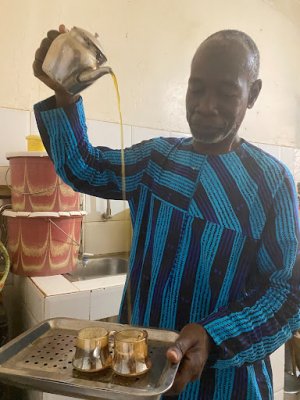In this post, Ryan and Olivia reflect on their experience with food in Senegal.
Food and Culture
Food and cooking are a central part of culture and over these last four weeks, our group has enjoyed cooking and eating local foods. Learning about the norms surrounding meals provides a window into peoples’ daily lives and the cultural values of Senegal. Both dinner and lunch in Senegal are typically eaten communally out of the same large platter. Families gather around and eat together, with the matriarch distributing the meat/protein out during the meals. Historically in Senegal, meals were eaten using your right (“clean”) hand. Before the meal a dish with soap and water is set out for washing your hands. After the meal a second dish is brought out with fresh water to clean them again. Today, eating with your hands or using a utensil are both common practices and choosing which one is a personal preference.
Breakfast
Breakfast in Senegal tends to be on the lighter side. The French influence seems to be most prominent in this meal. Breakfast here typically consists of NesCafe with powdered milk and a baguette with either leftovers from the night before, chocolate spread, or Laughing Cow spreadable cheese. Interestingly, there are two competing brands of chocolate spread here, Délia and ChocoPain, and nearly every household seems to have loyalty to one kind!
Lunch
Lunch is both the biggest meal and my (Ryan) favorite meal of the day. It generally consists of a protein (usually chicken or fish), rice, and vegetables—what changes are the spices and sauces that compliment the dish. Ceebu jёn is my personal favorite thus far, consisting of tomato-based dish of fish, rice, and mixed veggies. It is not only my preference but also the national dish of Senegal with origins in the old Senegalese capital of Saint-Louis. Since my mother is Djola (an ethnic group originated in the Casamance region), many of our dishes have an influence from the Casamance, which is a reflection of food’s regional diversity.
Snacks
In addition to meals, Senegal has some amazing snacks. One of my (Olivia) favorite foods is fataya. Fataya consists of thin fried dough, typically in either a triangle or half-moon shape. Inside the pastry is a filling of ground beef and onions. Typically fataya is served with a spicy onion sauce and ketchup. In addition to this, it is occasionally served on a baguette in more of a sandwich form. We often have fataya in the afternoon or evening, normally around 5pm or 6pm. This is the perfect filling snack since dinner is served later, around 9:30 or 10pm here.
Food and Gender
While each family approaches meals and food differently, in my family (Olivia) the women do nearly all of the cooking and food preparation. This is a relatively common dynamic in Senegal. One of my older host sisters does the majority of the cooking for the family and makes lunch everyday. Returning from school and spending time in the kitchen with her has become one of my favorite parts of my daily routine. While the men in my house do not participate in the cooking process, my younger host brothers are responsible for washing the dishes and helping clean up after meals.
The cooking roles of my (Ryan) family are generally the same. Most of the time the women do all of the cooking, but there is no snacking. However, the roles seem less rigid relative to other families since I have helped cook a few times now. In contrast, the general custom here is that men make the attaya tea and my host dad has shown me how to make it for the family. Similarly, I have been allowed to cut mangoes for the family. The mangoes are picked from our two large mango trees—this is something I did not expect to be able to do coming into SST. This has reflected the diversity of family role distributions both here and back home because each family seems to decide roles for itself while following a traditional cultural framework.
Food, Ceremonies and Celebrations
On a final note, ceremonies and celebrations play a big role in Senegalese culture and this is reflected in their food traditions. One of these ceremonies is Muslim baptisms called “ngénte li” (Wolof for baptism). For Muslims, babies are baptized just one week after they are born and simultaneously given a name. A religious leader called an “imam” comes to announce the parent-given name and bless the baby.
Eating way too much food while there, I (Ryan) was invited to go to a ngénte li earlier this week. During this all-day celebration, the practice is to serve “le laax” (another Wolof word) sometime before announcing the baby’s name. Le laax is millet porridge with sour milk. The traditional lunch, eaten usually around 2 or 3pm, is called ceebu yapp; this dish uses sacrificed meat (usually sheep or goat) and rice with veggies. Of course, the Chinese green tea called attaya follows the meal and is served typically in rounds of increasing sweetness. I was both grateful and lucky to have been able to partake in such an experience which broadened my cultural and culinary knowledge—something that would not have been possible without the generous teranga (hospitality) one can find here.





No comments:
Post a Comment